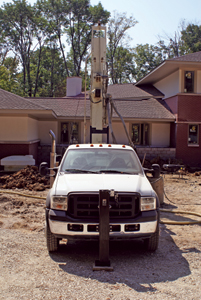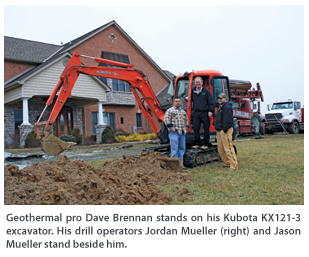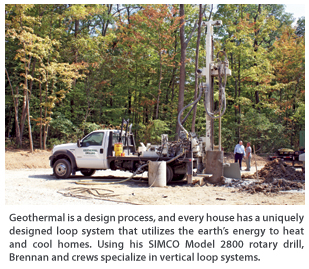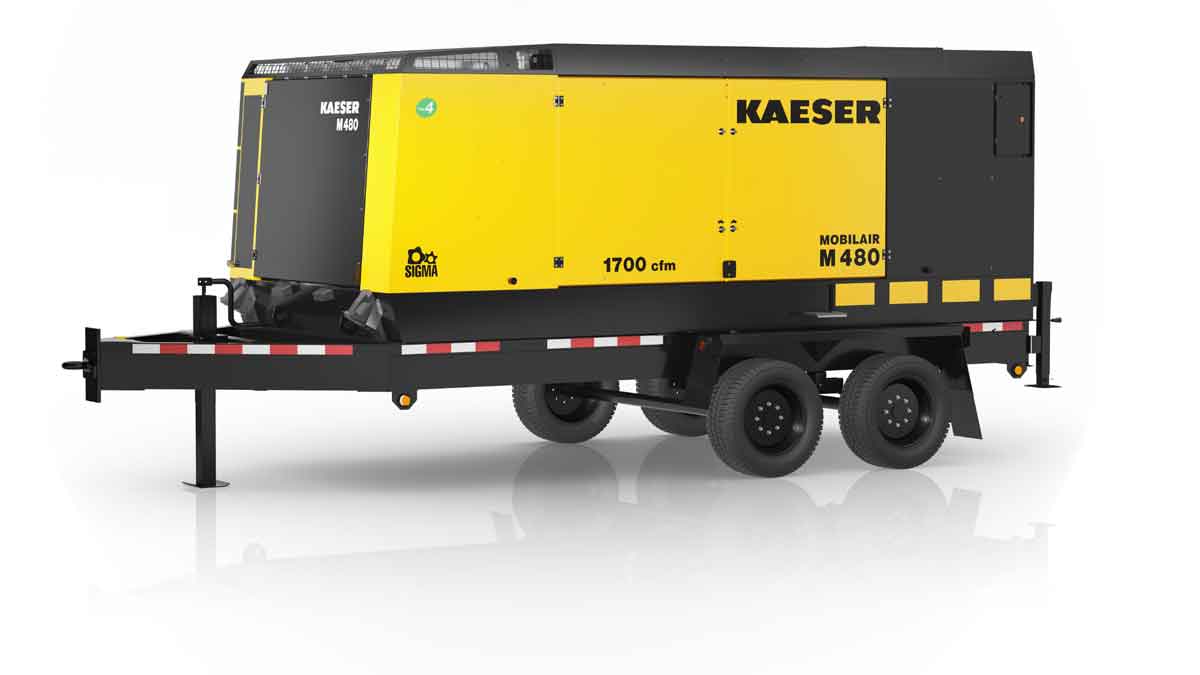Ground Control

Dave Brennan is in a unique business — capturing the earth’s energy for customers. With his company Geothermal Drilling LLC, his crews roll up to a residential home with a drill and a mini ex to install an underground loop system (a series of pipes carrying water and antifreeze) that capitalizes on the constant temperature of the earth to heat and cool homes.
“The earth is just a large radiant storage ball for the sun,” muses Brennan. “And it’s renewable. As long as the sun comes up, it’s going to continue to produce heat. Basic physics say that heat energy will move to the colder medium. So geothermal is really like a heat pump, and the loop is a series of piping much like a radiator. So the loop is either in heat or in cooling mode — it has two functions — and we’re going to draw that energy out of the earth and bring into your home.”

“I would say for a heating contractor in this area, I can’t speak for the rest of the country, but if you’re not into geothermal you’re actually pretty late getting on board,” says Brennan. “In the last two years, the market has really taken off, especially with the downturn in the economy, we found what we call the air-to-air market — that’s the standard air conditioner and gas furnace — that market took a real dive. I’d say in the last two years, there have been only two markets for heating and air conditioning: The people who were doing bare minimum replacement and those looking for high-end, ultra-high-efficient green solutions and that’s geothermal.”
Controlling the Loop
Geothermal Drilling LLC is based in Cincinnati, Ohio, and although Brennan has been working on geothermal installations for nearly two decades, four years ago he started this new company (with co-partner Spike Helmers) in order to focus on the industry’s biggest workload — digging and drilling loops. “In the geothermal industry, if you control the loop, you control the market,” explains Brennan.
So four years ago, the company invested in the equipment tools of the trade — a SIMCO Model 2800 rotary drill, Kubota KX121-3 excavator (with both 24- and 12-in. buckets), Geo Loop 50-500 grouting system, Ingersoll Rand 750 and 300 air compressors, pipe fusion tools, drill rods, bits, water pumps and the wheels and trailers to haul it all. Brennan’s first job was his own home. A SIMCO sales representative came out to his house and stayed for nearly a week training his team while they drilled and installed a system. “Learning to operate the equipment was challenging, but the biggest learning curve was yet to come,” he says.
Brennan learned quickly: The only rule of thumb in geothermal installation is that no two jobs are alike. Today, his company offers a myriad of installations for customers big and small, primarily in the retail, residential sector. There are a variety of unique loop systems that homeowners can choose, but most fall in the vertical and horizontal loop categories. Both styles of loop use a similar principal, getting most of their energy from the consistent temperature of the earth. In the northern part of the United States (and in the southern Ohio/Indiana area), the earth remains a constant 50 to 55 F year round. In the winter time, this heat is absorbed by a loop system (a series of pipes carrying water and antifreeze) under your yard into a geothermal furnace in your house where the heat energy is compressed to a higher temperature. The result is a warm and comfortable home.
“We send water down there at 30 or 40 F into a 50-degree ground. Heat energy from the ground will move to the water,” explains Brennan. “We can bring that heat energy into the water around what’s called the heat exchanger, which is the pipe inside of a pipe. The water is moving around this refrigerant. Now this refrigerant pipe — it’s colder yet. So if it’s running in the 20-degree range, heat energy moves from the water to the refrigerant.”
That compressor is able to take that heat energy and move it to an air coil where the house air blows over it with a fan and then that heat energy moves toward the cooler air in your house. In the summertime, the process reverses. The hot air from a home will move across that air coil and the heat energy of the air will go to the refrigerant. That colder refrigerant absorbs the heat. That heat in the refrigerant will then move to the cooled water and then you take that heated water back into the ground where it’s cooled again.

Brennan and company can do both styles of loops, but he prefers vertical loops, especially with his residential focus as a contractor.
“It’s really about space availability,” says Brennan. “Obviously, we favor vertical since we own the drill, but I just believe that vertical’s work better — especially around here. We’ve done a lot of horizontal systems over the years because it was very cost-prohibitive to even try to drill vertically, but it’s gotten better. Utility rates are higher, so the cost becomes more justifiable. People are spending the extra for vertical systems now.”
Vertical loops can be installed on smaller subdivision properties or where future land use requires the loop field to be kept to a smaller area. With vertical installations, a drill typically drills one hole for each ton of geothermal equipment (just remember, there’s no rule of thumb). The depth of these holes is determined by the required heating and cooling of the home and by the drilling conditions. Occasionally, more than one hole per ton is needed if the drilling conditions are poor. The holes are typically placed 12 to 15 ft apart from one another. The process usually takes about a week.
The Path of the Driller
Today the primary equipment in Brennan’s geothermal toolbox are his SIMCO drill and his Kubota mini ex. The company’s compact, ruggedly built SIMCO 2800 is an all-hydraulic, top-head-drive drill rig, fitted to the chassis of class 5 commercial truck. This smaller style of rig offers cost-effective drilling matched to the size of the job, which makes it ideal for residential jobsite installations. With the 10-in. stroke mast, hoisting winch and other options, the 2800 is a multi-purpose drill that can be used for auger drilling, mud or air rotary drilling, core drilling, down-the-hole hammer drilling and geothermal.
“Locating the loop is the first process, so we get the guys out there with the drill first,” says Brennan, noting a drill team usually consists of two to three workers, depending on mud mixing. “Our drill’s considerably smaller compared to the majority of them. The most common drills are 54,000 lbs — almost 60,000 lbs, depending on how much stuff they’re carrying. Ours is on a 550 Ford chassis — weighs about 19,000 lbs. We went that way for a couple of reasons. Any large drill that was used would be over $300,000. New ones were $500,000 to $600,000. New, this SIMCO was $177,000. Plus, the smaller drill is going to lend itself better to what we do residentially.”
First, Brennan and his crew figure out the best placement for the vertical system with the homeowner. “We always get their input. Sometimes they say, ‘I’m looking to put a pool in here next year,’ and you’re like ‘ok, we don’t have to put it there.’”
Most of the circuits for residential installation are about 150 ft (although circuits range up to 300-ft lengths), with one circuit for each ton of the system. Most homes run with three- or four-ton systems. Each circuit is a hole drilled by the SIMCO drill, eventually installing black, high-density, polyethylene pipe for the loop. Brennan’s crews have been perfecting the best ways to install systems in southern Ohio’s diverse ground conditions for four years, noting it’s a business where 10 years is the minimum time before you get the designation of “driller.”
“I always tell people drilling is like a box of chocolates — you never know what you’re going to get,” smiles Brennan. “Fortunately in Ohio — in these three counties — Clermont, Butler and Hamilton County — they have the most complete geographical record of any of the counties in Ohio. That always gives us a good idea what we’re getting into. We’re around five rivers and the glaciers all came down to southern Ohio and melted, so you can drill in one place and immediately be drilling into shale, limestone, sand or gravel.”
Using everything from hammer bits that cost $5,000 to small $150 little drag bits, Geothermal Drilling LLC bores through each unique jobsite using its wet drill, which utilizes Baroid bentonite mud mixes to lubricate the ground and keep the integrity of the hole open for work. After pressure-testing the circuits, pipe is dropped down the hole and grouted into place. The team grouts to ensure the hole is completely full and there is complete contact between the piping and the surrounding earth. This enables proper heat transfer and ensures the loop will operate at full capacity. Then the mini excavator comes into to do all of the digging and restoration, trenching down about 4 ft, staying out of the way of landscaping, to connect the system to the house. With its load-sensing hydraulic system, simultaneous four-function operation, big bucket breakout forces and smooth boom operation, the KX121-3 is highly productive — especially with a dig depth of 11 ft, 6 in. and a heated and air conditioned cab.

Last year alone Geothermal Drilling LLC tackled about 65 installs, which means they’re running every week. Even though Brennan has 20 years worth of geothermal experience and four years worth of drilling experience, he’s still surprised how much he learns each and every week (whether it’s navigating dangerous, odorless gas pockets, avoiding subsurface utilities or just building the perfect unit for his customers).
“Drilling is hard,” says Brennan. “All the manufacturers make a fairly decent piece of equipment. You just got to put enough loop in. It’s an expensive venture because it’s nothing where a service tech can come and readily see a problem. If it comes down to the final determination that you don’t have enough loop, that’s a big problem. Some of these are underneath driveways. Some are put out underneath landscaping that can cost thousands of dollars. These people just put in their dream home; they just put their geothermal in and the loop is out there in the yard. They’ve put in all the hardscapes around the yard with these big trees and now we’ve got to bring in this nasty drill and tear it all up again.”
Folks who decide on geothermal installation know what they want, so ensuring they’re satisfied with the product is essential. Most of these residential installations have a serious cost — about $20,000 to $30,000 for the system and installation for the homeowner. It’s an expensive venture and Brennan notes these are some of the most well-researched customers he’s worked with. One of the biggest incentives for these customers is a 30 percent tax credit from the government for installation (til 2016 with no cap). On a typical new home, by the time you calculate cost into the mortgage and what the geothermal will save over the lifetime of the equipment, a customer’s net operating cost for a typical three- or four-bedroom home will actually be $30 or $40 less a month. The eco-minded, cost-friendly benefits sell themselves. The installation just needs to fit the size of the home and the needs of the customer. The keys are correct planning, good equipment and working with the customer (even if you make a mistake).
“If I screw up, I just work hard to fix it,” Brennan smiles. “And you’re going to make mistakes. Stay humble. If you don’t know something, there’s someplace to find the answers. And if you have any doubt when going in, find out the answer first. If you’re like me, you won’t get lucky. You’re apt to screw up. There are more things that can go wrong, then can go right — let’s just put it that way.”
Keith Gribbins is managing editor of Compact Equipment, based in Peninsula, Ohio.
Sound Advice
Dave Brennan Shares His Insights into the Geothermal Business
When asked to give some advice to upcoming geothermal professionals, the first thing I thought of was to work within one’s capabilities. If a heating and air conditioning contractor wants to expand his or her product offering to geothermal, he or she should learn all they can about the product, proper service and installation. Geothermal heating and cooling is a design process; there is no rule of thumb when it comes to accepting thousands of dollars for an installation that may or may not work if not designed properly. Most manufacturers require contractors to attend a training course on their equipment before any equipment can be purchased. The International Ground Source Heat Pump Association (IGSHPA) is the main source for geothermal equipment and loop installation principles and training. IGSHPA offers regular training and a schedule of classes can be seen on its Web site at www.igshpa.org.
Once a contractor begins to install geothermal, he or she will quickly learn that the loop installation will be the most difficult part of the process to complete. Scheduling a loop installation requires being able to do the installation within the company or subcontracting the process out to a loop contractor or drilling company. Currently, there is a large demand for geothermal installation, but there are few loop installers and drillers to complete the process. If you do not have any of the equipment necessary for installing vertical geothermal loops, you will spend anywhere from $350,000 to $700,000 to get started. Learning the business takes some time and mistakes can be expensive.
Our company, Geothermal Drilling LLC, installs residential vertical and horizontal geothermal loops primarily, as well as some small commercial projects. Getting started, I suggest staying away from the commercial projects until you become more experienced. Residential is less demanding and your money is not tied up as long. Pricing, like any business, is based on cost of operation, so be sure to figure in plenty for maintenance and repair. Do not get caught up in the low price game; there is plenty of demand for the service. Stay on the good side of fellow drillers in your area as well. They are a good source of information and are willing to help you out as long as you do not undercut prices.





Comments are closed here.